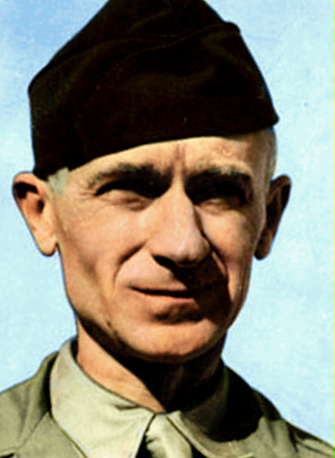
Roving Reporter
By Ernie Pyle
IN THE MARIANAS ISLANDS (delayed) – Maj. Robinson, the airplane commander of “my” crew, has been leading his boys through almost two years of training before they came overseas.
“That means a lot to have been together so long, doesn’t it?” I asked.
“It means everything,” one of the sergeants said. “We’re a team.”
So far, the crew has been lucky. They’re all intact except for the bombardier, who had his leg almost blown off, and is now back in Hawaii in a hospital.
To show how they feel about their being a team, the enlisted men asked especially if I would put the bombardier down as still part of the crew, even though he isn’t here anymore. They’d been together so long, and they liked him so much. He is Lt. Paul O’Brien of Dayton, Ohio.
My crew has a superstition, or rather just a tradition. They all wear the same kind of cap when they start in a mission. It’s a dark blue baseball cap, with the figure “80” on the crown in yellow numbers.
Caps were prize
They got the caps a couple of years ago in Minneapolis when they were there on a weekend trip for winning some kind of merit prize. The “80” was their unit number then, and although it ae long since ceased to exist, they insist on keeping it.
Once in a while Maj. Robinson used to forget his cap, and the enlisted men would send somebody back after it before the mission started.
But they’ve lost two of the caps now. One was Lt. O Brien’s, and he took it with him when he was evacuated. The other was Maj. Robinson’s. His cap got so bloody from Lt. O’Brien’s wound that he had to throw it away.
My crew lost their first plane right on the field when a Jap bomb got it. It was named Battlin’ Betty after Maj. Robinson’s wife, so now he’s changing the name of his newly inherited ship from Small Fry to Battlin’ Betty II.
Post-war project
Maj. Robinson carries a movie camera with him on every mission. He has already taken about 1,500 feet of color movies, but can’t have them developed until he gets back to America. He’s got them sealed up in moisture-proof cloth for safekeeping against the tropical climate.
The other night when he came into the hut after a 14-hour mission over Tokyo, he held up his movie camera for me to see, and said:
Now I’m satisfied to quit. I got the picture today that should end it.
There was a Jap fighter diving at the squadron ahead of us. He apparently didn’t see us at all, for he pulled up and turned his belly to us and just hung there, wide open. Every gun in our squadron let him have it. He just blew all to pieces. And I got the whole thing. So now I’m ready to lay it aside.
Vital member
One of the most vital members of a bomber’s family is the ground crew chief, even though he doesn’t fly. But he’s the guy who sees that the airplane does fly.
A good crew chief is worth his weight in gold. Maj. Robinson says he has the finest crew chief in the Marianas. I could believe it after seeing him.
He is Sgt. Jack Orr of Dallas. He’s a married man, tall and good-looking and modest. He is so conscientious it hurts, and he takes a mission harder than the crew members do themselves.
Maj. Robinson said that on one trip they had some trouble, and were the last ones in, long after the others had landed. It did look kind of bad for a while.
Sgt. Orr was waiting for them at the “hard stand.” Maj. Robinson said that when they got out of the plane, he was all over them, jumping up and down like a puppy dog, shouting and hugging them, and they could hardly get him stopped, he was so happy.
Maj. Robinson says he was sort of embarrassed, but I’ve heard him tell it two or three times, so I know how touched he was. There is indeed a fraternalism in war that is hard for people at home to comprehend.